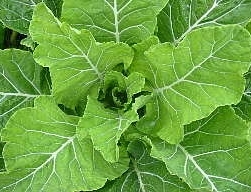Tree Cabbage
Tree cabbage looks like a tree-sized stalk with edible, palm-like leaves growing from the top. It's highly nutritious and related to Brussels sprouts, cabbage, and cauliflower. Give tree cabbage a chance and it just might surprise you with its productivity and sweet taste.
VarietiEs
Tree cabbage is an unusual edible and it can be hard to find seeds or cuttings. Varieties include Paul & Becky's Asturian Tree Cabbage, Jersey Cabbage or Walking Stick Kale.
WHERE TREE CABBAGE THRIVES
Regional compatibility
Tree cabbage does well in hot areas where similar vegetables, like cabbage and kale, are prone to bolting and tasting bitter. But it's adaptive enough that it can just as easily be grown in cold climates where its leaves turn a beautiful purple in winter.
Optimal shade & sun
Tree cabbage grows best in full sun locations, but it prefers partial shade in hot climates.
RESILIENCE
Adaptability to climate extremes. Tree cabbage is a hardy vegetable and highly adaptable. It can withstand a wide range of temperatures, from snow to 100 plus degrees, and it's drought-tolerant. It's also less prone than its relatives kale and cabbage to heat-driven bolting, which is when a plant grows quickly and starts to flower.
Drought resistance. Tree cabbage is a hardy vegetable, tolerant to nearly all climates, and droughts are no different. However, it fares better with heat (even equator heat) than dryness—be sure to water regularly if drought conditions allow. Tree cabbage is also less prone to bolting from environmental conditions compared to its relatives kale and cabbage, which can be helpful in droughts.
PREP YOUR SOIL
Optimal type of soil. Tree cabbage is among the few perennial vegetables that prefer a heavy clay soil, which helps anchor this very tall plant. But it grows well in almost any soil.
PLANTING
When planting indoors
Tree cabbage are difficult to grow. They require cuttings, not just seeds, and can take a while to root. Choose a cutting with at least five to six leaf nodes, and remove all leaves except for the smallest ones towards the top. Plant in a four to six inch deep pot and keep in shade or indirect sunlight under a plastic bag for about eight weeks. Watch out for bolting (early flowering). If that happens you'll have to start over again. Water one to two inches per week. After eight weeks inside they're ready to move outside. Allow the soil to dry out before you make the transfer.
When planting in the garden
Once the soil warms up in the spring, you can plant cuttings directly into the garden. Upturn a transparent gallon milk jug over your cuttings to serve as a mini-greenhouse, and give them a chance to take root. As the weather warms, remove the milk jug or you risk frying your plants.
Growing
Tree cabbage grows for a very long time so don't be afraid to prune heavily. By doing so you'll be helping it out in the long run and making your plant even more robust. Tree cabbage also tends to grow woody branches after a few years. It's important to cut those back. Be sure to also prune any side shoots—you want all the leaves to be growing from the very top so all of the plants energy can go into growing more tasty leaves. Because of the size of tree cabbage, weeds are not typically a barrier to growth.
WaterinG
Water weekly at least one to two inches worth to keep plants healthy. For mature plants you can water once every two weeks or when you notice the leaves starting to droop.
Mulching
Not usually necessary for tree cabbage, especially when mature. A light mulch could be used when first transplanted to the ground.
CHALLENGES
pests
Aphids, slugs, and thrips can attack tree cabbage and eat its leaves so check underneath the leaves regularly to pick them off. If this is a persistent issue, you can spray an insecticidal soap onto the leaves once a week.
Diseases
Tree cabbage can become afflicted by club root disease, especially in acidic soils. You can prevent club root by adding lime each season to keep the soil at a near neutral pH, and planting tree cabbage in well- drained soils.













